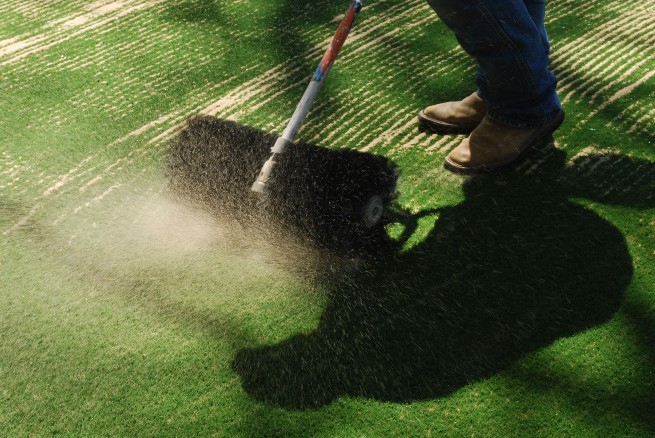Silica Sand Artificial Grass Infill
Silica sand artificial grass infill serves as a remarkably fine and arid infill sand commonly employed in the installation of artificial grass. Sourced from naturally occurring quartz, this infill is entirely natural, composed of minute, angular granules of sand primarily composed of silica. Following the laying of the artificial grass, a layer of silica sand is gently dispersed over the surface, settling amidst the grass blades and resting atop the backing. When applied evenly, it retains the original appearance of your grass without causing any soiling. Furthermore, it doesn’t stick to your feet and remains firmly in place, wind dispersal.
The Fundamental Role of Infill Material
In the world of artificial grass, the choice of infill material goes beyond mere aesthetics. It profoundly influences the performance and appearance of artificial turf, making silica sand artificial grass infill an indispensable component.
The Impact of Silica Sand on Artificial Grass Quality
Unmatched Drainage Efficiency
One of the standout features of silica sand is its exceptional drainage capabilities. By efficiently channeling water through its granular structure, silica sand prevents water-logging and sustains the longevity of your artificial grass.
Structural Support and Upright Appearance
Silica sand infill provides the necessary structural support to artificial grass, ensuring that its blades remain upright. This not only contributes to the overall appearance but also maintains a uniform and aesthetically pleasing surface.
Resisting Compaction and Wear
In high-traffic areas, the issue of compaction and wear can arise. Silica sand addresses this concern by its inherent resistance, ensuring that the artificial grass retains its plushness and visual appeal even under the duress of frequent use.
The ideal artificial grass installation with Silica Sand Infill
Silica Sand Distribution
The even distribution of silica sand within your artificial grass is key to its performance. This prevents displacement of the infill material, maintaining a consistent and attractive appearance across your entire lawn.
UV Resilience
The long-term vibrancy of your artificial grass is also safeguarded by silica sand. It acts as a protective barrier against the damaging effects of UV rays, ensuring that your synthetic turf retains its colour and integrity even with extended sun exposure.
By recognising the multifaceted role of silica sand in artificial grass installations, you can truly appreciate its impact on the efficiency, quality, and longevity of your synthetic turf. This infill material is far from a simple accessory; it’s an essential element in ensuring a successful and visually appealing artificial grass project.
How is the sand evenly distributed across the artificial grass surface?
At times, we employ a sizeable drop spreader for a seamless and uniform application of sand onto the brushed-up grass. Alternatively, a DIY-friendly method involves puncturing slits at the base of the sandbag and then briskly moving the bag back and forth across the designated area. Subsequently, a sturdy broom or brush can be used to ensure an even dispersion of the sand within the turf. This meticulous process aids the silica sand in settling deeply at the base of the artificial turf. It is imperative to ensure that the artificial turf is completely dry before commencing the silica sand application, as a damp surface could lead to clumping, hindering the sand from effectively reaching the base of the pile.
What are some other types of infills for artificial turf?

- Rubber Granules:
Description: Recycled rubber granules, often derived from tires, are used as infill material. For example SBR Rubber Softfall.
Benefits: Rubber infills offer a cushioning effect, making them ideal for areas with higher foot traffic, like playgrounds and sports fields.
Ideal Use: Commonly used for sports fields, playgrounds, and areas where shock absorption is essential.
- Thermoplastic Elastomer (TPE):
Description: TPE infill consists of a blend of rubber and plastic materials, offering durability and softness.
Benefits: TPE provides good shock absorption and drainage properties while being eco-friendly and resistant to UV rays.
Ideal Use: Suitable for sports fields, lawns, and playgrounds.
- Organic Materials:
Description: Organic infill materials include options like cork and coconut fibers.
Benefits: They are eco-friendly, offer good shock absorption, help keep the bad odour away and maintain a cooler surface temperature.
Ideal Use: Best for landscaping, lawns, and areas where a natural look is desired.
Check out our Aguachill artificial sand infill that keeps the grass cooler and also acts as an anti odour agent.
- Acrylic-Coated Sand:
Description: Acrylic-coated sand combines regular sand with a polymer coating.
Benefits: It provides durability and helps maintain the appearance of the artificial grass.
Ideal Use: Suitable for lawns and residential applications.
Selecting the right infill material depends on your specific project requirements and preferences. Each type of infill comes with its unique set of benefits, so consider your priorities regarding appearance, performance, and maintenance when choosing the infill that best suits your artificial grass installation.


